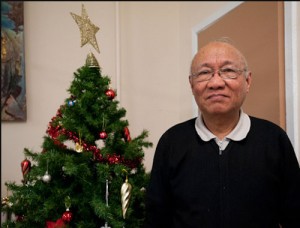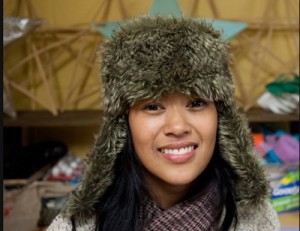Christmas in the Filipino Diaspora
Christmas in the Filipino Diaspora
By Dyan Ruiz and Joseph Smooke
In the Philippines and Canada, Christmas is a time for food, celebration, mass, and most of all a time for family. But many Filipino-Canadians long for the deep family connection of a Filipino Christmas they left behind as they adjust to a new life in Canada.
The Kababayan Community Centre in Parkdale and the Kapisanan Filipino Centre for Arts and Culture in Kensington Market orient much of their December programs toward Christmas. Representatives and participants from these centres fondly remember Christmas in the Philippines and struggle to find new ways to celebrate despite the fact that migration has left families fragmented and often challenged just to maintain contact with each other and their traditions.
“I feel like Christmas in Canada gets shorter and shorter whereas Christmas in the Philippines lasts for four months” recalls Victoria Marie Sawal, age 18, from Kapisanan’s Clutch program about her childhood growing up in the Philippines.
In the Philippines, Christmas unofficially starts in early September with decorations going up in the streets and malls. “It’s in the news; it’s everywhere, but here in Canada it’s like oh it’s the week before Christmas let’s put up a tree real quick and we’ll celebrate on that night,” Sawal says with a tinge of longing in her voice. “My family misses spending that quality time together without it feeling rushed.”
The Catholic Church officially begins Christmas celebrations in the Philippines with dawn masses, Misa de Gallo, on December 16. The celebrations culminate with midnight mass and a family feast after Noche Buena on December 24 that lasts into the early hours of December 25 says Dr. Rofel Brion, professor of interdisciplinary studies, literature, and creative writing at Ateneo de Manila University.
Aguido Dela Cruz, Chairperson of the Board of the Kababayan Community Centre grew up in the provinces. He explains that this is harvest time in Mindanao, so during the week leading up to Christmas, fathers are working in the rice fields while mothers are cooking all day. Children go caroling from house to house, and sometimes the adults join in the fun.
This year’s Christmas is especially poignant for Dela Cruz, whose hometown is just a three hour bus ride from the areas now suffering from the devastating floods of Typhoon Sendong.
Efforts to assist the victims of the typhoon this year are heightened by the long traditions of giving during the Christmas season. In the Philippines, the tradition is for “children in smaller communities go house to house on Christmas day to receive gifts of money, candies, fruits from relatives, friends, and even strangers” Brion said. This tradition of giving exists in Canada as well.
Joel Cuevas of Scarborough tells of the happiness he felt when he first encountered the Toronto Star’s Santa Claus Fund which collaborates with Toronto firefighters to “provide gift boxes to 45,000 needy children” as reported on the Star’s website.
Cuevas’ children wrote letters to Santa Claus and turned them in at the Santa Claus Parade one year. Just weeks later, unexpectedly, a group of firefighters arrived at their house with gifts much to the children’s excitement. Ever since then, Cuevas has donated to the fund so other children can have the same experience.
Programs like this are important because many recent immigrants are now dislocated from either their immediate or extended families. Dela Cruz, notes that many seniors and caregivers don’t have any family with whom to spend Christmas so the Kababayan Community Centre’s seasonal celebrations are crucial for their sense of belonging.
Being a part of a community is essential for a person’s well-being. To break the emptiness of isolation, some Filipino-Canadians include those who would otherwise be alone during Christmas. “Here, we have more people over, because my parents invite people like family friends who don’t have any relatives here in Canada to spend Christmas with” 19-year-old Diane Guison said at Kapisanan as she sat among a constellation of brightly coloured handmade parols made by Clutch program participants.
“We know one family and they just came here last year, and they don’t have anyone, so that’s why we invited them to join our family gathering, because we know they don’t have anyone, and it would be sad for them if they just spend it by themselves. They have dinner every day by themselves, so if they have Christmas by themselves too that’s just sad.”
The parties, caroling or karaoke, dinners, gift giving and mass are all important because they are ways for families and friends to be together. As more Filipinos move to Canada and children are born here to immigrant parents, new traditions are forming around the realities of the Filipino diaspora. Here are some from Kapisanan’s Clutch participants.
“After mass we go either to my aunt’s or my own house. It’s karaoke times and good food times and opening gifts.” Charise Aragoza, age 19, said. “My mom’s side of the family comes over on Christmas day. My dad’s side of the family lives in the Philippines.”
“On the 24th we would spend the whole day cooking so we could have a midnight meal. We would go to mass in the morning of the 25th, ” Kat Estacio, age 26, said. “We would spend each year at the house of a different family member. Now our family is in California and in the Philippines so we don’t have that kind of family gathering. During Christmas, we call our family– it’s better now because there’s Skype.”
From Manila to Toronto, refrains of Ang Pasko ay Sumapit (Christmas is Here) and other carols will be filling the night before Christmas from churches to homes and shared over the phone and skype networks as Filipinos and Filipino-Canadians search through the diaspora for ways to maintain traditions and create new ones that strengthen families and community bonds at Christmas time.








Comments (1)